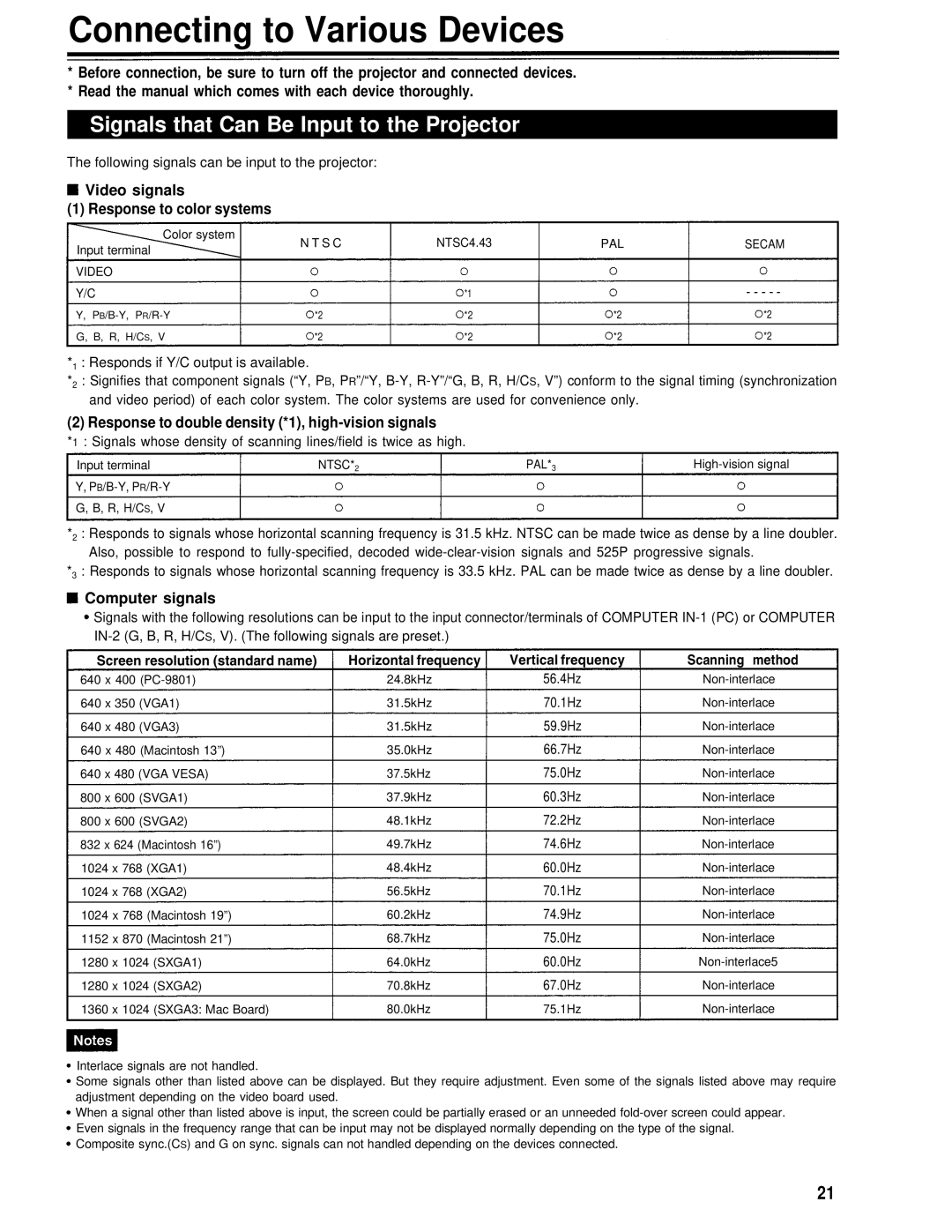
Connecting to Various Devices
*Before connection, be sure to turn off the projector and connected devices.
*Read the manual which comes with each device thoroughly.
Signals that Can Be Input to the Projector
The following signals can be input to the projector:
Video signals
(1) Response to color systems
Color system | N T S C | NTSC4.43 | PAL | SECAM | |
Input terminal | |||||
|
|
|
| ||
VIDEO |
|
|
|
| |
Y/C |
| *1 |
|
| |
Y, | *2 | *2 | *2 | *2 | |
G, B, R, H/CS, V | *2 | *2 | *2 | *2 |
*1 : Responds if Y/C output is available.
*2 : Signifies that component signals (“Y, PB, PR”/“Y,
(2) Response to double density (*1), high-vision signals
*1 : Signals whose density of scanning lines/field is twice as high.
Input terminal | NTSC*2 | PAL*3 | |
Y, |
|
|
|
G, B, R, H/CS, V |
|
|
|
*2 : Responds to signals whose horizontal scanning frequency is 31.5 kHz. NTSC can be made twice as dense by a line doubler. Also, possible to respond to
*3 : Responds to signals whose horizontal scanning frequency is 33.5 kHz. PAL can be made twice as dense by a line doubler.
Computer signals
Signals with the following resolutions can be input to the input connector/terminals of COMPUTER
Screen resolution (standard name) | Horizontal frequency | Vertical frequency | Scanning method |
640 x 400 | 24.8kHz | 56.4Hz | |
640 x 350 (VGA1) | 31.5kHz | 70.1Hz | |
640 x 480 (VGA3) | 31.5kHz | 59.9Hz | |
640 x 480 (Macintosh 13”) | 35.0kHz | 66.7Hz | |
640 x 480 (VGA VESA) | 37.5kHz | 75.0Hz | |
800 x 600 (SVGA1) | 37.9kHz | 60.3Hz | |
800 x 600 (SVGA2) | 48.1kHz | 72.2Hz | |
832 x 624 (Macintosh 16”) | 49.7kHz | 74.6Hz | |
1024 x 768 (XGA1) | 48.4kHz | 60.0Hz | |
1024 x 768 (XGA2) | 56.5kHz | 70.1Hz | |
1024 x 768 (Macintosh 19”) | 60.2kHz | 74.9Hz | |
1152 x 870 (Macintosh 21”) | 68.7kHz | 75.0Hz | |
1280 x 1024 (SXGA1) | 64.0kHz | 60.0Hz | |
1280 x 1024 (SXGA2) | 70.8kHz | 67.0Hz | |
1360 x 1024 (SXGA3: Mac Board) | 80.0kHz | 75.1Hz |
Interlace signals are not handled.
Some signals other than listed above can be displayed. But they require adjustment. Even some of the signals listed above may require adjustment depending on the video board used.
When a signal other than listed above is input, the screen could be partially erased or an unneeded
21
